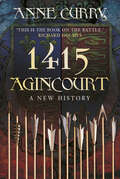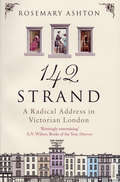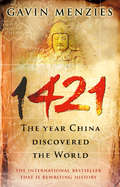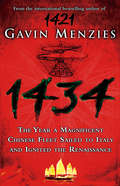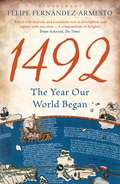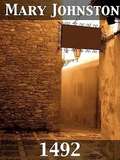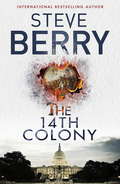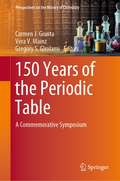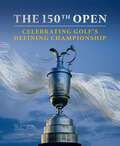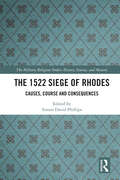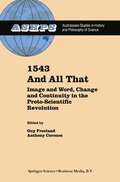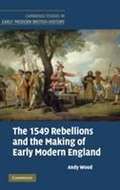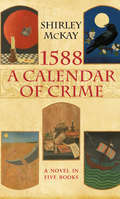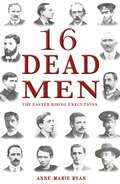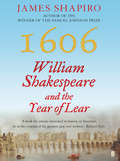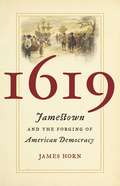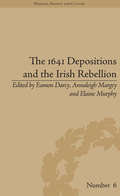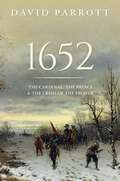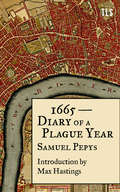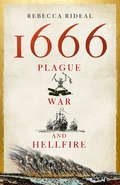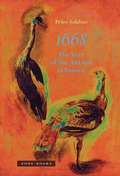- Table View
- List View
1415 Agincourt: A New History
by Anne CurryFor many commentators then and now, it was the English archers who won the day for Henry V. This lavishly illustrated history re-tells the story of the battle and Henry V's Normandy campaign from the perspective of the commander of the English archers, Sir Thomas Erpingham. Sir Thomas, an experienced warrior with military experience dating back 40 years is known for his brief but pivotal appearances in Shakespeare's Henry V, where he is correctly portrayed as an elderly, white haired veteran. At 57 he was one of the oldest there and a close personal confident of the King. But what was his background? How did he command his archers to such a place in history? And what role did the longbow and battlefield tactics play in the final analysis of victory?
142 Strand: A Radical Address in Victorian London
by Rosemary Ashton142 Strand was the home of the brilliant, unconventional young publisher John Chapman. All the daring and avant-garde writers and thinkers of Victorian London gathered here, among them Carlyle, Dickens, Thackeray; Americans like Emerson and refugees from revolutionary Europe like Mazzini. In 1851 Chapman brought Marian Evans - the future George Eliot - to London where her arrival caused rows in the household, which included Chapman's wife and also his mistress.The Strand was packed with booksellers, magazine publishers, theatres, clubs, and quack doctors. Only a short distance away were Westminster, the Houses of Parliament and the disreputable pornographers of Holywell street. Chapman's circle touched all these worlds, and the vivid story of these unconventional lives and unorthodox views - marvellously told by Rosemary Ashton - takes us to the heart of Victorian culture, uncovering its surprising energy, its doubts and arguments, and, above all, its passionate reforming spirit.
1421: The Year China Discovered The World (P. S. Series)
by Gavin MenziesOn 8 March 1421, the largest fleet the world had ever seen set sail from China. The ships, some nearly five hundred feet long, were under the command of Emperor Zhu Di's loyal eunuch admirals. Their mission was 'to proceed all the way to the end of the earth to collect tribute from the barbarians beyond the seas' and unite the world in Confucian harmony. Their journey would last for over two years and take them around the globe but by the time they returned home, China was beginning its long, self-imposed isolation from the world it had so recently embraced. And so the great ships were left to rot and the records of their journey were destroyed. And with them, the knowledge that the Chinese had circumnavigated the globe a century before Magellan, reached America seventy years before Columbus, and Australia three hundred and fifty years before Cook...The result of fifteen years research, 1421 is Gavin Menzies' enthralling account of the voyage of the Chinese fleet, the remarkable discoveries he made and the persuasive evidence to support them: ancient maps, precise navigational knowledge, astronomy and the surviving accounts of Chinese explorers and the later European navigators as well as the traces the fleet left behind - from sunken junks to the votive offerings left by the Chinese sailors wherever they landed, giving thanks to Shao Lin, goddess of the sea.Already hailed as a classic, this is the story of an extraordinary journey of discovery that not only radically alters our understanding of world exploration but also rewrites history itself.
1434: The Year A Chinese Fleet Sailed To Italy And Ignited The Renaissance
by Gavin MenziesIn his bestselling book 1421:The Year China Discovered the World, Gavin Menzies revealed that it was the Chinese that discovered America, not Columbus. Now he presents further astonishing evidence that it was also Chinese advances in science, art, and technology that formed the basis of the European Renaissance and our modern world.
1492: The Year Our World Began
by Felipe Fernandez-ArmestoThe world would end in 1492 - so the prophets, soothsayers and stargazers said. They were right. Their world did end. But ours began. In search of the origins of the modern world, 1492 takes readers on a journey around the globe of the time, in the company of real-life travellers, drawing together the threads that began to bind the planet: from the way power and wealth are distributed around the globe to the way major religions and civilizations divide the world. Events that began in 1492 even transformed the whole ecological system of the planet. Wars and witchcraft, plagues and persecutions, poetry and prophecy, science and magic, art and faith - all the glories and follies of the time are in this book.
1492
by Mary JohnstonIn the 15th century, a fabulous journey awaited those who could unlock the secrets of the Earth's geography. Beautifully written and emotionally compelling, 1492: Admiral of the Ocean-Sea tells of the famous adventures of Columbus and his men, who sailed into the almost mythical seas beyond the horizon in search of the "New World," in the hopes of attaining vast wealth and power. <P> <P> This brilliant book, by best-selling author Mary Johnston, traces the long route taken by explorers hoping to locate Asia. Based on their limited means and understanding of navigation, they struggle to find their position, while at the same time encountering many natural wonders and exotic peoples. Tensions build as they appear to become increasingly lost. Columbus and his crew begin to lose hope, until they finally receive the vindication of their bold vision. 1492: Admiral of the Ocean-Sea pays special attention to the conditions of the late 15th century period. It describes the competition between classes and ethnic groups in Spain, as well as the clashes that occurred when people from two very different cultures, native American and European, interact. These issues are not merely abstract, since we see them vividly through the eyes of a disenfranchised individual: a Christian sailor of Jewish background, who has been compelled to lead a secretive and solitary existence. The incidents of his life are brought to us in a handsome, elegant language, uncommon in the books of our day.
The 14th Colony: Book 11 (Cotton Malone #11)
by Steve BerryThe electrifying new Cotton Malone thriller by international bestseller Steve Berry.People say the Cold War is coming back.For some, it never went away.Shot down over Siberia in what was to be a simple meet-and-greet mission, ex-Justice Department agent Cotton Malone is forced into a fight for survival against Aleksandr Zorin, whose loyalty to the former Soviet Union has festered for decades into an intense hatred of the United States.Before escaping, Malone learns that Zorin is headed for North America to join another long-term sleeper embedded in the West. Armed with a Soviet weapon long thought to be just a myth, Zorin is aided by a shocking secret hidden in the archives of America's oldest fraternal organization, the Society of Cincinnati. Past presidents used this group's military offensive - including advice on the invasion of what was to be America's 14th Colony - Canada.Inauguration Day for a new President of the U.S.A. is only hours away. Zorin's deadly plan is timed to bring about political chaos.In a race against the clock from Russia to the White House itself, Malone must not only battle Zorin, he must also confront his deepest fear, a crippling weakness that he's long denied but one that now jeopardizes everything. Steve Berry's trademark mix of fact, fiction, history and speculation is all here in this fast-paced and utterly compelling new thriller.
150 Jahre Gesetzgebung in Deutschland: Entwicklungen des Gesetzgebungsverfahrens von der konstitutionellen Monarchie 1871 bis zur parlamentarischen Demokratie 2021
by Martin H. MöllersDieses Buch erläutert die verfassungsmäßige Ausgestaltung der Gesetzgebungsverfahren im Kaiserreich, in der Weimarer Republik und in der Bundesrepublik Deutschland im Zusammenhang. Dadurch wird nachvollziehbar, dass die Gesetzgebung der heutigen parlamentarischen Demokratie ihre Basis bereits in der konstitutionellen Monarchie des Deutschen Kaiserreichs vor 150 Jahren hat. Obwohl das Verfahren der Gesetzgebung im Kaiserreich vordemokratisch ausgestaltet war, sind ihre wesentlichen Merkmale bis heute unverändert. Welche Änderungen die Gesetzgebungsverfahren von Verfassung zu Verfassung im Einzelnen erfuhren, analysiert das Buch und stellt heraus, dass diese Änderungen vor allem das Bund-Länder-Verhältnis, die Volkssouveränität sowie den Einfluss der Grundrechte auf die Gesetzgebung betrafen. Dabei kommen auch Auffassungen der Staatsrechtslehre früherer Zeiten zur Rechtsstaatlichkeit zur Sprache, die immer noch zum derzeitigen Meinungsspektrum zählen, heute jedoch nicht mehr zu halten sind. Zudem dokumentiert das Buch, wer an den Gesetzgebungsverfahren offiziell und wer faktisch beteiligt war bzw. noch ist und welche politischen Einflussnahmen auf die Gesetzgebung im Lauf der Geschichte festzustellen sind. So wird u.a. dokumentiert, dass insbesondere der Mangel an Transparenz der Zusammenarbeit von Exekutive und Legislative mit Lobbyisten dazu führt, dass viele Gesetze einzelne Bevölkerungsgruppen oder Wirtschaftszweige bevorzugen.
150 Years of the Periodic Table: A Commemorative Symposium (Perspectives on the History of Chemistry)
by Carmen J. Giunta Vera V. Mainz Gregory S. GirolamiThis book provides an overview of the origins and evolution of the periodic system from its prehistory to the latest synthetic elements and possible future additions. The periodic system of the elements first emerged as a comprehensive classificatory and predictive tool for chemistry during the 1860s. Its subsequent embodiment in various versions has made it one of the most recognizable icons of science. Based primarily on a symposium titled “150 Years of the Periodic Table” and held at the August 2019 national meeting of the American Chemical Society, this book describes the origins of the periodic law, developments that led to its acceptance, chemical families that the system struggled to accommodate, extension of the periodic system to include synthetic elements, and various cultural aspects of the system that were celebrated during the International Year of the Periodic Table.
The 150th Open: Celebrating Golf's Defining Championship
by Iain Carter The R&ACelebrating 150 years of The Open.
The 1522 Siege of Rhodes: Causes, Course and Consequences
by Simon David PhillipsIn 1522 the Ottomans attacked the island of Rhodes and, after a six-month siege, the Hospitallers surrendered on terms. The Knights Hospitaller had ruled Rhodes since 1309 and the Ottomans had attempted to capture the island forty years before in 1480, but were defeated by the Knights. The Ottoman victory in 1522 resulted in the Knights being expelled from the island and eventually settling in Malta, Gozo, and Tripoli, and the Ottomans obtaining domination over the Eastern Mediterranean and its trade. This collection of essays, published on the 500th anniversary of the siege, explores such question as why Suleiman the Magnificent attacked Rhodes, what made the 1522 siege successful, and how the Rhodian population, the Knights Hospitaller, the Eastern and Western Mediterranean and Europe in general were affected by the loss of Rhodes. The answers to these questions are explored in new research by expert historians and archaeologists in their field. This book will appeal to all those interested in the Knights Hospitaller, Ottoman History, Crusader Studies, and Early Modern European History.
The 1522 Siege of Rhodes: Causes, Course and Consequences
by Simon David PhillipsIn 1522 the Ottomans attacked the island of Rhodes and, after a six-month siege, the Hospitallers surrendered on terms. The Knights Hospitaller had ruled Rhodes since 1309 and the Ottomans had attempted to capture the island forty years before in 1480, but were defeated by the Knights. The Ottoman victory in 1522 resulted in the Knights being expelled from the island and eventually settling in Malta, Gozo, and Tripoli, and the Ottomans obtaining domination over the Eastern Mediterranean and its trade. This collection of essays, published on the 500th anniversary of the siege, explores such question as why Suleiman the Magnificent attacked Rhodes, what made the 1522 siege successful, and how the Rhodian population, the Knights Hospitaller, the Eastern and Western Mediterranean and Europe in general were affected by the loss of Rhodes. The answers to these questions are explored in new research by expert historians and archaeologists in their field. This book will appeal to all those interested in the Knights Hospitaller, Ottoman History, Crusader Studies, and Early Modern European History.
1543 and All That: Image and Word, Change and Continuity in the Proto-Scientific Revolution (Studies in History and Philosophy of Science #13)
by G. Freeland Anthony CoronesAustralia and New Zealand boast an active community of scholars working in the field of history, philosophy and social studies of science. Australasian Studies in History and Philosophy of Seien ce aims to provide a distinctive publication of essays on a connected outlet for their work. Each volume comprises a group theme, edited by an Australian or a New Zealander with special expertise in that particular area. In each volume, a majority of the contributors is from Australia or New Zealand. Contributions from elsewhere are by no means ruled out, however, and are indeed actively encouraged wherever appropriate to the balance of the volume in question. Earlier volumes in the series have been welcomed for significantly advancing the discussion of the topics they have dealt with. I believe that the present volume will be greeted equally enthusiastically by readers in many parts of the world. R. W Horne General Editor Australasian Studies in History and Philosophy of Science ix LIST OF ILLUSTRATIONS Frontispiece. Andreas Vesalius, Sixth Plate ofthe Muscles, woodcut, designed by Jan Steven van Kalkar, from De humani corporis fabrica (Basel, 1543). (Photo. Scientific Illustration; repr. by kind permission of the University of New South Wales Library. ) In: GUY FREELAND, 'Introduction: In Praise of Toothing-Stones' Fig. 1. Michael Esson, Vesalian Interpretation 3 (1992). (Repr. by kind permission ofthe Artist. ) Fig. 2. Reliefs, University of Padua.
The 1549 Rebellions and the Making of Early Modern England (Cambridge Studies In Early Modern British History Ser.)
by Andy WoodThis is a major new study of the 1549 rebellions, the largest and most important risings in Tudor England. Based upon extensive new archival evidence, the book sheds fresh light on the causes, course and long-term consequences of the insurrections. Andy Wood focuses on key themes in the new social history of politics, concerning the end of medieval popular rebellion; the Reformation and popular politics; popular political language; early modern state formation; speech, silence and social relations; and social memory and the historical representation of the rebellions. He examines the long-term significance of the rebellions for the development of English society, arguing that they represent an important moment of discontinuity between the late medieval and the early modern periods. This compelling new history of Tudor politics from the bottom up will be essential reading for late medieval and early modern historians as well as early modern literary critics.
1588: A Novel in Five Books (1588: A Calendar of Crime #6)
by Shirley McKayA novel in five books featuring:A grisly murderA vanishing corpseA secret romanceA ghostly tale for HalloweenAn innocent accused1588. It is a dark and turbulent time. Scotland’s queen has been executed, the Spanish king seeks revenge, and the people of St Andrews cling desperately to the rhythm of the old ways.The ancient burgh is renowned throughout Europe as a seat of Church and learning but it is also a town full of suspicion, conspiracy and murder. Shirley McKay sets her intriguing and sometimes comic tale around the key points in the calendar: the four quarter days of Candlemas, Whitsun, Lammas, Martinmas and the feast day of Yule.When the first victim is discovered on Candlemas Eve, Hew Cullan, scholar and lawyer, is called upon to investigate; the dark side of the sixteenth century comes alive in a rich tapestry infused with the textures of history and folklore, woven by a master crime writer.
16 Dead Men: The Easter Rising Executions
by Anne-Marie RyanSixteen men were executed in the aftermath of the Easter Rising in Ireland, 1916: fifteen were shot and one was hanged. Their deaths changed the course of Irish history. But who were these leaders who set in motion events that would lead to the creation of an independent Ireland? The executed leaders of the Easter Rising were a diverse group. This book contains fascinating accounts of the life stories of these men and recounts the events that brought each of them to rebellion in April 1916.
1606: William Shakespeare and the Year of Lear
by James Shapiro1606: William Shakespeare and the Year of Lear traces Shakespeare's life and times from the autumn of 1605, when he took an old and anonymous Elizabethan play, The Chronicle History of King Leir, and transformed it into his most searing tragedy, King Lear. 1606 proved to be an especially grim year for England, which witnessed the bloody aftermath of the Gunpowder Plot, divisions over the Union of England and Scotland, and an outbreak of plague. But it turned out to be an exceptional one for Shakespeare, unrivalled at identifying the fault-lines of his cultural moment, who before the year was out went on to complete two other great Jacobean tragedies that spoke directly to these fraught times: Macbeth and Antony and Cleopatra.Following the biographical style of 1599, a way of thinking and writing that Shapiro has made his own, 1606: William Shakespeare and the Year of Lear promises to be one of the most significant and accessible works on Shakespeare in the decade to come.
1619: Jamestown And The Forging Of American Democracy
by James HornAn extraordinary year in which American democracy and American slavery emerged hand in hand.
The 1641 Depositions and the Irish Rebellion (Warfare, Society and Culture)
by Eamon Darcy Annaleigh Margey Elaine MurphyThe 1641 Depositions are among the most important documents relating to early modern Irish history. This essay collection is part of a major project run by Trinity College, Dublin, using the depositions to investigate the life and culture of seventeenth-century Ireland.
The 1641 Depositions and the Irish Rebellion (Warfare, Society and Culture #6)
by Eamon Darcy Annaleigh Margey Elaine MurphyThe 1641 Depositions are among the most important documents relating to early modern Irish history. This essay collection is part of a major project run by Trinity College, Dublin, using the depositions to investigate the life and culture of seventeenth-century Ireland.
1652: The Cardinal, the Prince, and the Crisis of the 'Fronde'
by David ParrottDavid Parrott's book offers a major re-evaluation of the last year of the Fronde - the political upheaval between 1648 and 1652 - in the making of seventeenth-century France. In late December 1651, Cardinal Mazarin defied the order for his perpetual banishment, and re-entered France at the head of an army. The political and military crisis that followed convulsed the nation, and revived the ebbing fortunes of a revolt led by the cousin of the young Louis XIV, the prince de Condé. The study follows in detail the unfolding political and military events of this year, showing how military success and failure swung between the two sides through the campaign, driving both cardinal and prince into a progressive intensification of the conflict, while simultaneously fuelling a quest for compromise and settlement which nonetheless eluded all the negotiators' efforts. The consequences were devastating for France, as civil war smashed into a fragile ecosystem that was already reeling under the impact of the global cooling of the 'Little Ice Age'. 1652 raises questions about established interpretations of French state-building, the rule of cardinal Mazarin and his predecessor, Richelieu, and their contribution to creating the 'absolutism' of Louis XIV.
1652: The Cardinal, the Prince, and the Crisis of the 'Fronde'
by David ParrottDavid Parrott's book offers a major re-evaluation of the last year of the Fronde - the political upheaval between 1648 and 1652 - in the making of seventeenth-century France. In late December 1651, Cardinal Mazarin defied the order for his perpetual banishment, and re-entered France at the head of an army. The political and military crisis that followed convulsed the nation, and revived the ebbing fortunes of a revolt led by the cousin of the young Louis XIV, the prince de Condé. The study follows in detail the unfolding political and military events of this year, showing how military success and failure swung between the two sides through the campaign, driving both cardinal and prince into a progressive intensification of the conflict, while simultaneously fuelling a quest for compromise and settlement which nonetheless eluded all the negotiators' efforts. The consequences were devastating for France, as civil war smashed into a fragile ecosystem that was already reeling under the impact of the global cooling of the 'Little Ice Age'. 1652 raises questions about established interpretations of French state-building, the rule of cardinal Mazarin and his predecessor, Richelieu, and their contribution to creating the 'absolutism' of Louis XIV.
1665 – Diary of a Plague Year
by Samuel PepysWelcome to London in lockdown – in 1665 This timely release of a year in the life of London’s greatest diarist comes with an introduction by bestselling author, Max Hastings.
1666: Plague, War and Hellfire (Not A Ser.)
by Rebecca Rideal1666 was a watershed year for England. The outbreak of the Great Plague, the eruption of the second Dutch War and the Great Fire of London all struck the country in rapid succession and with devastating repercussions.Shedding light on these dramatic events, historian Rebecca Rideal reveals an unprecedented period of terror and triumph. Based on original archival research and drawing on little-known sources, 1666: Plague, War and Hellfire takes readers on a thrilling journey through a crucial turning point in English history, as seen through the eyes of an extraordinary cast of historical characters. While the central events of this significant year were ones of devastation and defeat, 1666 also offers a glimpse of the incredible scientific and artistic progress being made at that time, from Isaac Newton's discovery of gravity to Robert Hooke's microscopic wonders. It was in this year that John Milton completed Paradise Lost, Frances Stewart posed for the now-iconic image of Britannia, and a young architect named Christopher Wren proposed a plan for a new London - a stone phoenix to rise from the charred ashes of the old city.With flair and style, 1666 shows a city and a country on the cusp of modernity, and a series of events that forever altered the course of history.
1668: The Year of the Animal in France (Zone Bks.)
by Peter SahlinsPeter Sahlins’s brilliant new book reveals the remarkable and understudied “animal moment” in and around 1668 in which authors (including La Fontaine, whose Fables appeared in that year), anatomists, painters, sculptors, and especially the young Louis XIV turned their attention to nonhuman beings.At the center of the Year of the Animal was the Royal Menagerie in the gardens of Versailles, dominated by exotic and graceful birds. In the remarkable unfolding of his original and sophisticated argument, Sahlins shows how the animal bodies of the menagerie and others (such as the dogs and lambs of the first xenotransfusion experiments) were critical to a dramatic rethinking of governance, nature, and the human.The animals of 1668 helped to shift an entire worldview in France — what Sahlins calls Renaissance humanimalism — toward more modern expressions of Classical naturalism and mechanism. In the wake of 1668 came the debasement of animals and the strengthening of human animality, including in Descartes’s animal-machine, highly contested during the Year of the Animal.At the same time, Louis XIV and his intellectual servants used the animals of Versailles to develop and then to transform the symbolic language of French absolutism. Louis XIV came to adopt a model of sovereignty after 1668 where his absolute authority is represented in manifold ways with the bodies of animals and justified by the bestial nature of his human subjects.1668: The Year of the Animal in France explores and reproduces the king’s animal collections — in printed text, weaving, poetry, and engraving, all seen from a unique interdisciplinary perspective. Sahlins brings the animals of 1668 together and to life as he observes them critically in their native habitats — within the animal palace itself by Louis Le Vau, the paintings and tapestries of Charles Le Brun, the garden installations of André Le Nôtre, the literary work of Charles Perrault and the natural history of his brother Claude, the poetry of Madeleine de Scudéry, the philosophy of René Descartes, the engravings of Sébastien Leclerc, the trans_fusion experiments of Jean Denis, and others.The author joins the non_human and human agents of 1668 — panthers and painters, swans and scientists, weasels and weavers — in a learned and sophisticated treatment that will engage scholars and students of early modern France and Europe and readers broadly interested in the subject of animals in human history.
